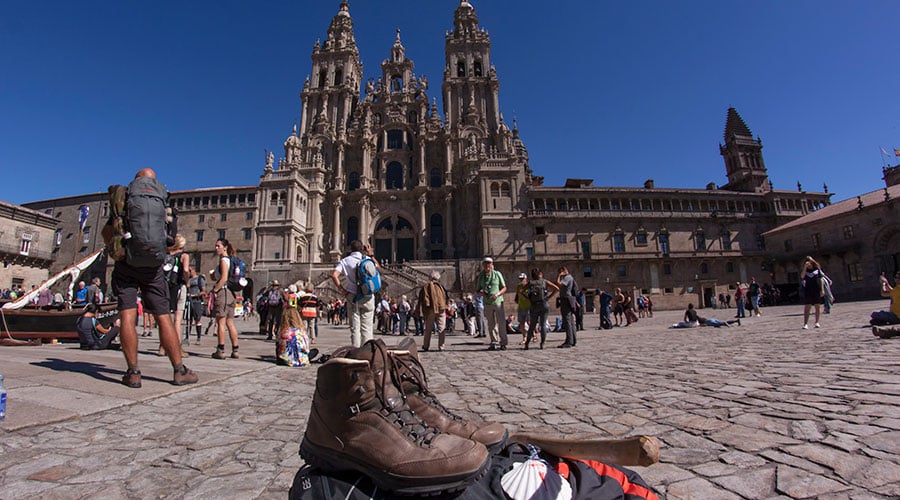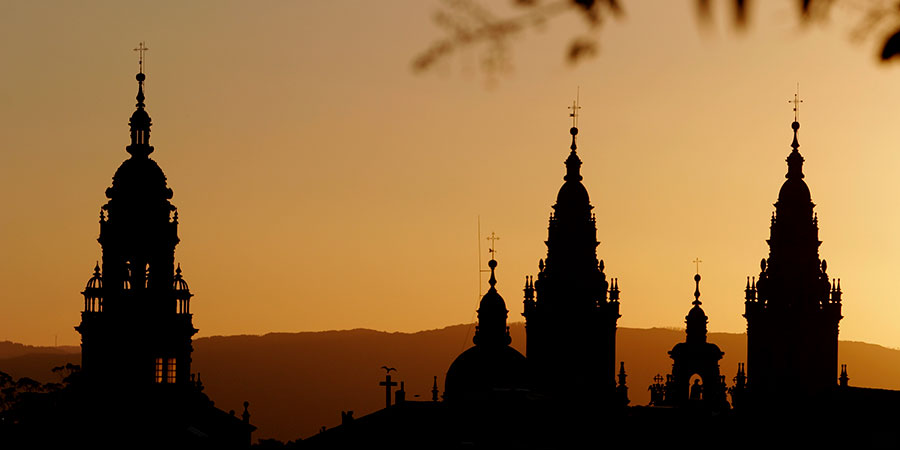Guide to Santiago de Compostela, End of the Camino
All Camino de Santiago routes lead to Santiago de Compostela, a city steeped in history and tradition. Known as St. James of the Field of Stars, Santiago is the capital of Galicia and has been a major pilgrimage destination for centuries. Since the 10th century, pilgrims from across the globe have made the arduous journey to Santiago to seek spiritual renewal, atone for their sins, and pay homage to St. James, believed to be buried in the city’s magnificent Santiago cathedral. This pilgrimage, known as the Way of St. James, is one of the most famous in the world. It draws thousands of pilgrims each year who traverse its various routes, all culminating in Santiago.
Table of contents
Santiago de Compostela Old Town
Santiago de Compostela is a city that brims with charm and character. Its picturesque Old Town, recognized as a UNESCO World Heritage site, offers a delightful blend of medieval architecture, cobbled streets, and vibrant cultural life. By day, the city bustles with activity as tourists and locals explore its historical landmarks, visit its museums and enjoy its cafes and markets. By night, the Old Town comes alive with a different energy, with its many bars, restaurants, and music venues offering a lively atmosphere.

In addition to its historical and cultural significance, Santiago de Compostela is a renowned university town. The University of Santiago, established in 1495, is one of the oldest universities in Europe. Its presence adds a youthful and dynamic vibe to the city, as students worldwide come to study and live here. Many of the university’s historic buildings are located in the Old Town, blending seamlessly with the city’s rich architectural heritage. This combination of academic prestige, historical significance, and vibrant culture makes Santiago de Compostela a unique and fascinating destination.
Things to do in Santiago de Compostela
There is plenty to do, see and taste in Santiago de Compostela; after visiting the cathedral and getting your Compostela certificate at the Pilgrims Office. Then take time to explore this wonderful historic city:
- Going for a stroll in the Alameda Park
- Getting a picture taken with As Marias
- Checking out the local produce in the popular Abastos food market
- Relaxing in peaceful Bonaval Park
- Tasting pinchos along the Rua do Franco
- Learning about the locals at the Museum of Galician People
- Sampling octopus, Galician style
- Visiting the Pilgrimage Museum
Or take the Santiago de Compostela Tapas Tour, a wonderful food discovery! Book your place now!
The Cathedral of Santiago de Compostela
Santiago de Compostela is the capital of Galicia. The city’s Cathedral is today’s destination, as it has been throughout history, of the important 9th-century medieval pilgrimage route, the Way of St. James (Camino de Santiago). In 1985, the city’s Old Town was designated a UNESCO World Heritage Site.
Legend has it that the remains of the apostle James were brought to Galicia for burial. In 813, according to medieval legend, a bright star’s light guided a shepherd watching his flock at night to the burial site in Santiago de Compostela.
The shepherd quickly reported his discovery to the bishop of Iria, Bishop Teodomiro. The bishop declared that the remains were those of the apostle James and immediately notified King Alfonso II in Oviedo. To honour St. James, the cathedral was built on the spot where his remains were said to have been found.

City of Santiago de Compostela
Santiago is also the site of the University of Santiago de Compostela, established in the early 16th century. The old town has many narrow winding streets full of historic buildings. Santiago de Compostela has a substantial nightlife. Divided between the new town (la zona Nueva or ensanche) and the old town (la zona Vieja or a zona Vella), a mix of middle-aged residents and younger students running throughout the city until the early hours of the morning can often be found.
The historic cathedral stands at the city’s centre, surrounded by granite-paved streets in the old town. Parque da Alameda, the city’s largest park, separates this historic area from the newer part of Santiago.Whether in the old town or the new town, party-goers often follow their tapas by dancing the night away.
Other sights in Santiago de Compostela
The city also has several other sights that are worth the visit. Some of them are the Museum of the Galician People, which provides a general view of Galician history and Culture; the Pilgrimage Museum, which highlights the importance, for European culture and Hispanic America, of the pilgrimage and worship of St. James; Galician Centre of Contemporary Art; And the Praza de Abastos (City Market). This market is the typical Galician market and one of the biggest in Spain.
It’s the perfect place to buy fresh seafood, vegetables, and meat. “Pulpo a la Gallega,” or cooked octopus, is a famous dish in Galicia. In general, many restaurants are selling fish and seafood suitable for all budgets. Be sure to sample the local cheeses and delicious cakes, including the famous “Tarta de Santiago.” For a quiet beer and tapas in the old district, several places offer terrace seating in good weather. When it’s rainy or cold, you can enjoy the cosy indoor spaces while savouring delicious local flavours.
For more information about the Camino de Santiago, please don’t hesitate to contact us.
Read more about Santiago:
- 10 things to do in Santiago de Compostela
- 24 hours in Santiago
- Insiders guide to Santiago de Compostela
- Best Restaurants in Santiago
FAQs
Q: Why is Santiago de Compostela famous?
A: Santiago de Compostela is the final destination of the Camino de Santiago, where pilgrims honour St. James at the city’s cathedral, a UNESCO World Heritage Site.
Q: What can I do in Santiago de Compostela after finishing the Camino?
A: Popular activities include visiting the cathedral, exploring the Old Town, tasting tapas on Rúa do Franco, strolling Alameda Park, and browsing the Mercado de Abastos food market.
Q: What is the legend of St. James in Santiago?
A: According to tradition, the remains of the apostle James were miraculously carried by boat to Galicia. A shepherd discovered his tomb in 813, leading to the creation of Santiago’s cathedral.
Q: Is Santiago de Compostela a good city break destination?
A: Yes, its mix of medieval charm, lively university culture, excellent food, and vibrant nightlife make it a great destination for both pilgrims and casual travellers.
Q: What food is Santiago de Compostela known for?
A: Must-try local dishes include Pulpo a la Gallega (octopus), regional cheeses, fresh seafood, and the almond cake Tarta de Santiago. See our Camino food guide for more inspiration.
Q: Can I get the Compostela certificate in Santiago?
A: Yes, after walking at least 100km or cycling 200km of an official Camino route, you can collect your Compostela at the Pilgrims’ Office in Santiago.